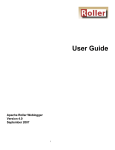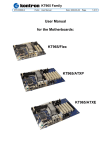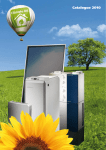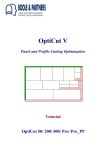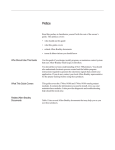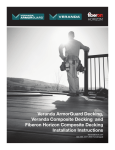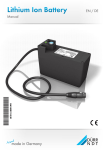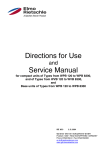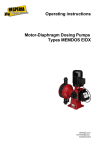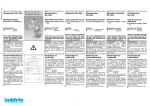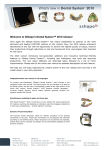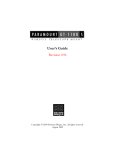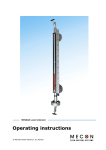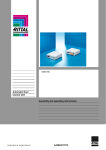Download Operating instructions - hebo
Transcript
281S Vertical sewage pump Type B/M Operating instructions Herborner Pumpenfabrik J.H. Hoffmann GmbH & Co. KG Address Littau 3-5 D-35745 HERBORN Phone +49 (0) 2772 933 - 0 Telefax +49 (0) 2772 933 - 100 Internet http://www.herborner-pumpen.de e-mail [email protected] Original operating instructions A - V1 30 GB Translation Copyright This operating instructions is to be translated into the language of the user country for shipment into countries of the European Economic Area. Transmission or duplication of this document, usage and communication of its content are prohibited if not expressly authorized. Violations create liability for damages. If inconsistencies should occur in the translation, please consult the original operating instructions (German) for clarification or contact the manufacturer. All rights reserved. Table of contents Table of contents 1. 1.1 1.2 Certificates ................................................ 4 Declaration of conformity ............................. 4 Declaration of manufacturer (for supply without drive unit) ....................... 5 2. 2.1 2.2 2.3 2.4 2.4.1 2.4.2 2.4.3 2.4.4 2.4.5 2.4.6 2.4.7 2.4.8 2.4.9 General ....................................................... 6 Explosion view ............................................. 6 Wear parts .................................................... 8 Usage according to intended purpose ........ 8 Specifications ............................................. 10 Type identification ...................................... 10 Impeller ....................................................... 11 Installations ................................................ 11 Shaft sealing ............................................... 11 Drive motor ................................................. 11 Coupling ..................................................... 11 Support of pump unit .................................. 12 Dimensions, weight, performance data ..... 12 General data ............................................... 12 3. 3.1 3.1.1 3.2 3.3 3.4 3.5 Safety ........................................................ 13 Notes / explanations .................................. 13 Machine identification ................................ 13 Integrated safety systems (Option) ............ 14 Interfaces on the pump .............................. 14 Safety instructions ...................................... 14 Responsibility of user ................................. 15 4. 4.1 4.2 4.3 General hazard notes .............................. 16 Hazards ...................................................... 16 Hazardous areas around the pump .......... 16 Assembling, operators and maintenance personnel ............................. 16 Installation of spare and wear parts .......... 16 Shutdown procedures ................................ 17 4.4 4.5 5. 5.1 5.2 5.2.1 5.2.2 5.3 5.3.1 5.3.2 5.4 5.4.1 5.4.2 5.5 5.6 5.6.1 5.6.2 5.7 5.8 5.9 5.9.1 5.10 Installation ................................................ 18 Scope of supply .......................................... 18 Transit and packing .................................... 18 Delivery (also of spares and wear parts) .. 18 Intermediate storage .................................. 18 Transit to the installation site (of the customer) ........................................ 18 Handling by a fork lift ................................. 19 Handling by crane ...................................... 19 Pump weights ............................................. 19 Pump weights, type B/BF ........................... 19 Pump weights, type M/MF ......................... 20 Installation and setup ................................. 20 Dimensions ................................................. 21 Installation lengths and dimensions of type B/BF ................................................ 22 Installation lengths and dimensions of type M/MF ............................................... 22 Power supply .............................................. 23 Motor protection ......................................... 23 Rotation sense control ............................... 24 Changing the rotation sense ..................... 24 Motor connection diagrams: ...................... 25 5.11 5.12 Routing of pipelines ................................... 25 Anti-freezing ............................................... 25 6. 6.1 6.2 Commissioning ........................................ 26 Operation modes and starting frequency .. 26 Starting ....................................................... 27 7. 7.1 7.2 7.5 7.6 7.7 Service / maintenance / cleaning ............ 28 Service ........................................................ 28 Maintenance instructions at prolonged periods of standstill .................................... 29 Bearing lubrication ..................................... 29 Bearing lubrication of motor shaft ............. 30 Bearing lubrication of pump shaft ............. 30 Re-lubrication ............................................. 30 Re-lubrication of anti-friction bearings ...... 30 Re-lubrication of slide bearings ................. 30 Re-lubrication by grease pump (available as an accessory only) ............... 30 Re-lubrication with lubricant dispenser (available as an accessory only) ............... 32 Couplings ................................................... 32 Cleaning ..................................................... 33 Tightening torques for bolts ....................... 33 8. Malfunction / cause / rectification ........... 34 9. 9.1 9.2 Disassembly / assembly ......................... 37 Disassembly ............................................... 37 Assembly .................................................... 43 7.3 7.3.1 7.3.2 7.4 7.4.1 7.4.2 7.4.3 7.4.4 Table of figures Fig. Fig. Fig. Fig. Fig. Fig. Fig. 2-1a 2-1b 3-1 3-2 5-1 5-2a 5-2b Explosion view ............................................. 6 Explosion view ............................................. 7 Nameplate .................................................. 13 Interfaces on the pump .............................. 14 Handling by crane ...................................... 19 Dimensions ................................................. 21 Dimensions ................................................. 21 Certificates 1. Certificates 1.1 Declaration of conformity EC-Declaration of conformity in terms of - the EC Machinery Directive 98/37/EC, Appendix II A (Version 2002) - the EC Low Voltage Directive 73/23/EWG, Appendix III (Version 2002) - the EC directive EMC 89/336/EEC, Appendix I and II (Version 2002) also with explosion-proof model: - the EU Directive Equipment and Protective Systems Intended for Use in Potentially Explosive Atmospheres 94/9/ EC (ATEX) We hereby state that the model with the Name: Vertical sewage pump Type: 281S corresponds to the above regulations and the DIN EN standards listed below in the supplied model: Directive / Standard Title EC Machinery Directive Version Comments 1998 Version 06/ 2004 98/37/EC DIN EN ISO Safety of machinery Basic concepts; 12100-1 general principles for design; Part 1: Basic terminology, methodology 2004 DIN EN ISO Safety of machinery; Basic concepts, general 12100-2 principles for design; Part 2; Technical principles and specifications 2004 DIN EN 809 Pumps and pump units for liquids 1998 DIN EN 1050 Safety of machinery- Principles for risk assessment; 1997 Directive / Standard Title Directive / Standard Title Version Comments EC directive EMC 1989 Version 06/ 2004 DIN EN 50081-1 Electromagnetic compatibility (EMC); 1993 Harmonised standards DIN EN 50082-2 Electromagnetic compatibility; Generic Immunity Standart; Industrial environment 1994 Harmonised standards Version Comments 89/336/EG also with explosion-proof model: Directive / Standard Title 1994 Harmonised standards EU Directive Equipment and 94/9/EG Protective Systems Intended (Atex 100a) for Use in Potentially Explosive Atmospheres Version 02/ 2004 Harmonised standards EN 1127-1 Explosive atmospheresExplosion pevention and protection - Part 1: Basic concepts and methodology 1997 Harmonised standards 2001 Harmonised standards Version Comments EC Machinery Directive 1973 Version 06/ 2004 DIN EN 60204-1 Safety of machinery; Electrical equipment of machines; Part 1: General requirements 1998 Harmonised standards DIN EN 62079 Preparation of instructions, Structuring, content and presentation 2001 Harmonised standards 73/23/EG EN 13463-1 Non-electrical equipment for potentially explosive atmospheres; Part 1: Basic method and requirements; prEN 13463-5 Non-electrical equipment indended for use in potentially explosive atmospheres; Part 5: Protection by constructional savety This statement becomes invalid with a non-coordinated change. Herborn, June 28, 2004 ............................................................... Signature (Management) 4 Certificates 1.2 Declaration of manufacturer (for supply without drive unit) Declaration of manufacturer in terms of - the EC Machinery Directive 98/37/EC, Appendix II B(Version 2002) also with explosion-proof model: - the EU Directive Equipment and Protective Systems Intended for Use in Potentially Explosive Atmospheres 94/9/ EC (ATEX) We hereby state that the model with the Name: Vertical sewage pump Type: 281S is delivered without a drive unit, for installation in a machine or for assembly with other machines to a machine. It is prohibited to start the machine until it has been verified that the machine into which this pump will be integrated or to which this pump will be assembled meets the provisions above and the DIN EN standards listed below. also with explosion-proof model: Directive / Standard Title EG-Richtlinie Maschinen Version Comments 1998 Version 06/ 2004 98/37/EG DIN EN ISO Safety of machinery 12100-1 Basic concepts; general principles for design; Part 1: Basic terminology, methodology 1991 DIN EN ISO 12100-2 1995 Safety of machinery Basic concepts, general principles for design; Part 2; Technical principles and specifications DIN EN 809 Pumps and pump units for liquids DIN EN 1050 Safety of machinery- Principles for risk assessment; 1998 1997 Harmonised standards Harmonised standards Directive / Standard Title Version Comments EU Directive Equipment and 94/9/EG Protective Systems Intended (Atex 100a) for Use in Potentially Explosive Atmospheres 1994 Version 02/ 2004 EN 1127-1 Explosive atmospheresExplosion pevention and protection - Part 1: Basic concepts and methodology 1997 Harmonised standards 2001 Harmonised standards EN 13463-1 Non-electrical equipment for potentially explosive atmospheres; Part 1: Basic method and requirements; prEN 13463-5 Non-electrical equipment indended for use in potentially explosive atmospheres; Part 5: Protection by constructional savety This statement becomes invalid with a non-coordinated change. Herborn, June 28, 2004 ............................................................... Signature (Management) 5 General 2. General 2.1 Explosion view Type B/BF Components 1. Lantern 2. Spacer bush** 4. Lubrication point 5. Deep groove ball bearing 6. Thrust ball bearing 7. Shaft tube 8b. Shaft seal ring 8c. Shaft seal ring 8e. Shaft seal ring 9. Intermediate bearing 10. Lubricating pipe 11. Shaft wearing sleeve 12. Stuffing box bearing 13. Vent plug 14. Casing 15. Cover 16. Impeller nut 17. Screwed flange 18. Impeller 19. Gland packing* 20. Bush 21. Bush 22. Shaft 23. Flange 24. Locking sleeve 25. Bearing mounting 26. Grooved pin 27. Circlip 28. Coupling 29. Cover 31. Bottom shaft 33. Locking sleeve 34. Bearing mounting 35. Top shaft 92. Joint 93. Washer 94. Joint 98. Motor Fig. 2-1a Explosion view * For DN100 replaced by shaft seal ring 8c ** For designs including grease lubrication pump replaced by V-rope pulley 6 General Type M/MF Components 1. Lantern 2. Spacer bush** 4. Lubrication point 5. Deep groove ball bearing 6. Thrust ball bearing 7. Shaft tube 8a. Shaft seal ring 8b. Shaft seal ring 8c. Shaft seal ring 8e. Shaft seal ring 9. Intermediate bearing 10. Lubricating pipe 11. Shaft wearing sleeve 12. Stuffing box bearing 13. Vent plug 14. Casing 15. Cover 16. Impeller nut 17. Screwed flange 18. Impeller 19. Gland packing* 20. Bush 21. Bush 22. Shaft 24. Locking sleeve 26. Grooved pin 27. Circlip 28. Coupling 29. Cover 31. Bottom shaft 33. Locking sleeve 34. Bearing mounting 35. Top shaft 56. Manhole cover 57. Pressure pipe gland 59. Pressure pipe 70. Support housing 71. Pressure pipe seal 92. Joint 93. Washer 94. Joint 95. Screwed flange 96. Blank flange 97. Joint 98. Motor Fig. 2-1b Explosion view * For DN100 replaced by shaft seal ring 8c ** For designs with grease lubrication pump replaced by v-belt pulley 7 General 2.2 Wear parts The specifications fort he selection of wear parts are based on the first demand for a two-year operation, in accordance with DIN 24 296. Wear parts No. of pumps (if existing) 1 2 3 4 5 6-7 8-9 10-... Impeller 1 1 1 1 2 2 2 20% Cover 1 1 1 1 2 2 2 20% Bushes 1 1 1 2 2 2 3 25% Anti-friction bearing set 1 1 1 2 2 2 3 25% Shaft seal ring set 1 1 1 2 2 2 3 25% Gland packing 1 1 1 2 2 2 3 25% Shaft wearing sleeve 1 1 1 2 2 2 3 25% Shaft + accessories 1 1 1 1 2 2 2 20% 2.3 Every pump is exclusively designed for a purpose as specified above. Any other use exceeding the intended purpose, or a modification of the pump without a written agreement by the manufacturer is considered as non-conforming to the intended purpose. The manufacturer will not be responsible for any damages resulting therefrom. The risk rests fully on the operator. The pump must not be operated unless it is ensured that all safety equipment are completely installed and function properly, and that the system into which the pump is installed meets the provisions. Usage according to intended purpose The pumps of the series indicated on the front page are suitable for the conveyance of: Nominal diameter 40-80 Sewage – soil water – waste water (for the drainage of heating cellars, boiler houses, heating centres, slaughter houses, washing rooms, sculleries, laundries, gully pits, etc.) Not allowed is the use of the pumps for conveying • combustible or explosive fluids; • fluids with abrasive constituents; • chemical agents attacking the pump material. Nominal diameter 100 Faeces – sewage – ground water pits – dirty waste water (particularly suited for removal of faeces from collective lines and pits). The media used for pump operation according to its intended purpose, and the hazards in connection with it are subject to the sole responsibility of the operator. For the conveyance of aggressive and/or abrasive media, bronze or special steels will be available as pump materials. In areas subject to explosion hazards, only pumps of explosionproof design (Ex) can be used, meeting the proper specifications. 8 General II 2G T1-T4 The use conforming to the intended purpose also includes the maintenance of the prescribed operation, maintenance and repair specifications. Temperature classes Explosion-proof gas atmosphere Equipment category Equipment group Ex-identification The explosion-proof vertical pumps / pump components (if supplied without drive units) meet the requirements of electric facilities subject to explosion-hazard, according to the Guideline 94/9/EC of the European Council, dated 23rd March 1994, for intended purpose use in explosionhazard areas of Equipment Group II Categories 2. By the temperature class T4, the pumps also meet the requirements of the temperature classes T1 to T3. Conditions of Use for Zone I and Zone II. The Ex-identification on the nameplate of the pump is related only to the pump components and the coupling provided by the manufacturer. The drive unit proper is subject to separate consideration. If the motor and the pump are of different identification, the lower specifications shall apply to both. Explosion-proof behaviour is ensured only for the use conforming to its intended purpose. The limits indicated in the purchase order and/or on the nameplate must not be exceeded, in any case. To maintain the explosion proof behaviour of the pump, if supplied without motor, the following conditions shall be maintained for the motor: The temperatures permitted on the motor flange and motor shaft must be higher than the temperatures developed by the pump. Pumps with an integrated motor and ATEX Certification, made by Herborner Pumpenfabrik, meet this condition. 9 General 2.4 Specifications 2.4.1 Type identification Example: 281SH/100-2SP-230-BF-925-EX-W1-S1 Design S1 = = Standard Special design of serial number Materials W0 = mixed materials W1 = all castings of EN-GJL-250 W2 = all castings except impeller of EN-GJL-250, Impeller of G-CuSn 10 W3 = all castings of G-CuSn 10 W4 = all castings of 1.4408 W5 = all castings of EN-GJS-400-15 W6 = all castings of 1.4439 Permitted usage EX = = Standard Explosion proof quality Dimension “e” Design = unsectioned version = sectioned version B = for installation in open pits M = for installation in tanks and shafts F Type Impeller diameter Impeller version (if deviating from standard) Number of blades Nominal diameter of pressure connection DN [mm] Hydraulic variation Pump type 10 General Motor cooling is effected by heat transfer of the cooling ribs to the ambient atmosphere. 2.4.2 Impeller Open screened impeller with automatic fibre cutting tool for safe conveyance. Follow the coolant temperature specified on the nameplate! 2.4.3 Installations The type series can be supplied in different installation types: Type B / BF = for installation in open pits Motor connection sizes according to DIN 42677 (IM B5). Protection system IP 55 Revolution rate 1450 (1750) /rpm (Standard) Frequency 50 (60) Hz Power supply < 2.2 kW 230/400 (265/460) V Power supply > 3.0 kW 400/690 (460) V Insulation class Type M / MF = for installation in tanks and shafts VDE 0530 F Type V1 Max. deviation of power supply permitted ±10%, for the explosionproof designs ±5% of the power rating. 2.4.4 Shaft sealing Sealing of all types is effected on the media-side via a gland packing (19), from DN 100 upward via shaft seal rings. For type M additionally by shaft seal rings (8a). Dry-running of a pump will destroy the shaft sealing! If a pump is delivered ex works without motor, the latter shall be set up according to the design data of the purchase order and the specifications indicated. 2.4.6 Coupling 2.4.5 Drive motor The pump is equipped with a three-phase a.c. squirrel cage motor. The exact motor data shall be derived from the nameplate! The manufacturer supplies pumps with elastic torsion claw couplings with elastic elements of PUR-plastics. Couplings for Ex-service are specifically identified by the EX-stamp and information referring to the manufacturer. 11 General 2.4.7 Support of pump unit On the drive side, the pump is supported by two anti-friction bearings with a re-lubricating facility in the bearing mounting (25.) / support housing (70.). In the split design (BF/MF), there are 2 additional anti-friction bearings in the bearing mounting (34.). The shaft is supported in the stuffing box bearing (12.) and intermediate bearing (9.) by lubricated slide bearings. These are either grease-lubricated or media-lubricated, depending on the conditions of use. The number of intermediate bearings (9.) depends on the construction length of the pump. 2.4.8 Dimensions, weight, performance data The dimensions and installation sizes are shown in chapter 5.6 Dimensions and the weights in chapter 5.4 Pump weights. The performance and connection data of each pump type are included in the purchase order and the nameplate data. 2.4.9 General data Media temperature range for: lower temperature limit: 0 °C upper temperature limit: +100 °C Ambient temperature range for: lower temperature limit: - 5 °C upper temperature limit: + 40 °C Density and toughness of pumped media: Density: max. 1000 kg/m3 Kinematical viscosity: max. 1 mm2/s (1 cST) For media of deviating density or toughness, make sure to observed motor performance in the case of hydraulic power change. Acoustic Pressure Level: The acoustic pressure level of the pump at cavitation-free operation in the Range of Qopt. remains below the limits specified in the EC-Guideline 98/37/EG for machinery. 12 Safety 3. Safety 3.1 Notes / explanations We recommend to paste the accompanying type nameplate of the pump into the operation manual or into the switchgear, so that they are available to you whenever you need them. Warnings are included in a frame and marked by a ”STOP sign”. Hazard notes are included in a frame and highlighted by a warning triangle. The nameplate is affixed to the fan cover above the switchbox or on the lantern (if supplied without drive unit). Hints are included in a frame and marked by a ”hand”. For queries and ordering of spare parts, make sure to indicate the pump type and the purchase order number. Follow any additional nameplates on the motor. Squeezing hazards are included in a frame and identified by the adjacent symbol. Hazards due to electric power are included in a frame and identified by the adjacent symbol. Hazards due to explosive atmosphere are included in a frame and identified by the adjacent symbol. Biological hazard Biological hazards may develop during decomposition of organic products in sewage waters. Instructions to wear personal safety outfit Fig. 3-1 Nameplate Are included in a frame and identified by the adjacent symbol. Legend to fig. 3.1 Burning hazard e.g. on electric motors are identified by the adjacent symbol. 3.1.1 Machine identification The data in the operating manual are exclusively applicable to the type of pump shown on the front page. 1. Purchase order no. 9. CE-mark 2. Type description 10. Nominal head 3. Item no. 11. Nominal flow rate[m3/h] [m] [min-1] 4. Frequency [Hz] 12. Rpm 5. Power output [kW] 13. Operation voltage [V] 6. Protection class 14. Year of construction 7. Insulation class F 15. Ex-proof identification (only for Ex-pumps) 8. Ex-mark (only for Expumps) 13 Safety 3.2 Integrated safety systems (Option) 3.3 Interfaces on the pump The integrated safety systems shall be inspected at regular intervals j = annually. The inspection methods to be applied are: S = visual inspection, F = functional checkout. Thermal winding protection If the pump is additionally protected by direct temperature control of the winding, the motor will be stopped at excessive heat-up. Checkout Interval Method j S, F Fig. 3-2 This operation manual is an integral part of the machine and must be available to the operators at any time. The included safety precautions shall be followed. Interfaces on the pump There are the following interfaces on the pump: 1. Inlet connector flange 2. Outlet connector flange 3. Electric connection (terminal box) 4. Re-lubricating unit It is strictly forbidden to cheat any safety equipment or to vary their functioning. 3.4 Safety instructions It is essential that the user instructs his operators and maintenance personnel: - on the protection equipment of the pump; - and supervises them to follow the safety provisions. 14 Safety This operation manual shall be retained for future reference. The frequency of inspections and supervision measures shall be maintained. The operations described in this manual are set up in such a manner that they are 3.5 Responsibility of user In the European Economical Region, the national adoption of the Framework Guideline (89/391/EEC) and the accompanying individual guidelines, in particular the Guideline (89/655/EEC) and the Minimum Probisions for Safety and Health Protection for the Use of Working Tools and Utilities by Working People, in their applicable wording shall be followed and maintained. - understood in the operation manual chapters handling and operation modes by an operator; - in the chapters transportation, installation and setup, maintenance, malfunction/cause/rectification by an experienced engineer. The chapters Transportation, Installation and setup, Maintenance, Malfunction/cause/rectification are provided for skilled engineers only. Operations described in these chapters shall be performed by skilled engineers only. Trained person The Working Safety Rules shall be observed. g The user shall strive to obtain the local operation permit and follow the impositions connected to it. At the same time, he shall meet the local provisions for A person trained by a skilled engineer to fulfil the functions assigned to him/ her and informed about the potential hazards in the case of improper behaviour an instructed, if required, about the protective equipment and safety provisions needed. - the safety of personnel (Provisions for the Prevention of Accidents) - the safety of working tools (Protection equipment and Maintenance) - the disposal of products (waste law) - the disposal of materials (waste law) - cleaning (cleaning agents and their disposal) - the protection of environment. Connections: Trained engineer A person who can judge the assigned duties and potential hazard on the basis of his/her technical education, know-how and experience as well as the relevant standards. Before operating the pump, the user shall ensure that during assembly and startup, if this is carried out by the user himself, the local provisions (e.g. for electric supply) are met. In its definition similar to EN 60204-1. 15 General hazard notes 4. General hazard notes 4.1 Hazards The safety systems and safety provisions described in this manual shall be use and followed., respectively. The pump shall be operated on the control elements or from a remote control system. Make sure to keep the access ways free from objects when opening the pump, so that an unobstructed access is possible at any time. 4.3 Assembling, operators and maintenance personnel The personnel required for assembly, operation and maintenance includes persons who are responsible for transportation, assembly, installation, operation, preparation, and cleaning of the pump and for troubleshooting. 1. The pump may be mounted and operated by trained and authorize persons only. 2. The responsibilities for operating the pump must be clearly established and followed, so as to avoid any misunderstandings and doubtful competences. During preparation, maintenance and repairs , make sure to avoid any squeezing hazards! 3. For all activities (operation, maintenance, repair, etc.) the shutdown procedures stated in the operation manual shall be followed. 4.2 4. The operator shall abstain from any handling mode that certainly would deteriorate the safety of the pump. Hazardous areas around the pump 5. The operator shall ensure that only authorised persons are allowed to work on the pump. For preparatory, maintenance, repair and cleaning activities, the area of about 1 m around the pump shall be regarded as a hazardous area. The operating area is limited to the operating controls. 6. The operator undertakes to report any changes occurred on the pump that would affect safety to the user immediately. 7. The user undertakes to operate the pump in an unobjectionable state only. 8. The user shall provide any protective equipment needed meeting the legal provisions and the requirements of the media to be conveyed. Make sure to install and/or fasten the pump so that no persons can stay in the direction of pumping 4.4 Installation of spare and wear parts We expressly point out that any spares and wear parts not delivered by us consequently are neither tested nor released by us. The installation and/or the use of such products may adversely affect the properties of your pump in terms of design and performance. The responsibility and liability of Herborner Pumpenfabrik will be excluded for any damage caused by the use of non-original components or non-original accessories. 16 General hazard notes 4.5 Shutdown procedures It is essential that the following shutdown procedure is maintained prior to any maintenance, cleaning and/or repair activities (by skilled personnel only). Disconnect the pump from power supply - Turn the power switch on the power supply cabinet to ”0”. - Make sure that no voltage is applied. - Secure the power switch against inadvertent re-starting by a padlock Close the open electric cabinets during cleaning, to avoid any ingress of water or dust. If not observed carefully, hazards will occur for the life and health of your operators! 17 Installation 5. Installation Packing for road traffic by lorry 5.1 Scope of supply For transport by road traffic, the pump is packed and fastened to a transit pallet. The detailed scope of supply is revealed in the order confirmation. 5.2.2 Intermediate storage On arrival, the freight packing of the pump and spare parts are laid out for approx. 3 months. Storage conditions The counter flange with thread ”G” according to the nominal width, is part of the supply for type B. Suitable motor sizes depending on lantern: Closed and dry room with an ambient temperature of 5 40 °C. 5.3 Transit to the installation site (of the customer) 80 L, 90 S, 90 L, 100 L, 112 M, 132 S, 132 M, 160 M, 160 L Motor connection sizes acc. to DIN 42677 (IM B5). 5.2 Transit and packing Transit shall be performed by skilled personnel under local conditions only. The pumps from Herborner Pumpenfabrik are carefully checked and packed prior to shipment, but no damage can be excluded during transit. 5.2.1 Delivery (also of spares and wear parts) Receiving inspection Check for complete delivery by comparison with the delivery note! The pump is transferred on the transit pallet right to the installation site of the customer. For damages Check the supply for damages (visual inspection)! For complaints If the delivery has been damaged during transit: - Immediately make contact with the last forwarder! - Keep the packing as an evidence (for a possible review by the forwarding agent or for return shipment). Packing for return shipment If possible make use of the original packing container and the original packing material. If both is no more available: - If available, request a packing company with expert personnel. Place the pump on a pallet (must be designed according to weight). - Any queries arising to packing and transport security should be referred to Herborner Pumpentechnik. 18 Hoisting gear and sling belts must be of sufficient dimension for the total pump weight (see chapter 5.4 Pump weights). If necessary, secure the pump during transit by appropriate sling gear, because there might exist a hazard of tilting, especially for topheavy objects. The pump shall be placed on a horizontal surface of sufficient firmness in all directions. Installation 5.3.1 Handling by a fork lift - The fork lift must be designed in conformity with the weight of the pump. 5.4 5.4.1 Pump weights, type B/BF - The driver shall have a proper driving license for moving loads by fork lift. 5.3.2 Handling by crane Type BF - Fasten the pump to the crane by means of appropriate sling gear (e.g. crossbeam, belt, multi-point suspensions, ropes, etc.) at the lifting points and move it. Type B - The crane must be designed for handling weights of the pump. - The operator must be authorized to operate a crane. Pump weights dimension ”e” [mm] 525 725 925 1025 1225 1450 1550 1650 1750 1850 1950 2050 2150 2250 2375 2450 2575 2675 2625 2825 3025 3125 3325 3550 3650 3750 3850 3950 4050 4150 4250 40 [kg] 47 50 53 54 57 63 65 66 68 69 71 72 73 75 79 78 82 84 100 103 105 107 110 116 117 119 120 122 123 124 126 50 [kg] 71 73 76 78 81 87 88 90 91 92 94 95 97 98 103 101 106 107 123 126 129 130 133 139 141 142 143 145 146 148 149 H65 [kg] 75 78 81 83 85 92 93 94 96 97 99 100 102 103 108 106 111 112 128 131 134 135 138 144 146 147 148 150 151 153 154 281S... 65 [kg] 169 174 179 181 185 197 200 202 204 206 209 211 213 216 225 220 229 232 253 257 262 264 269 280 283 285 287 289 292 294 296 80 [kg] 119 123 128 130 135 146 149 151 153 156 158 160 162 165 174 169 179 181 202 206 211 213 218 229 232 234 236 239 241 243 245 H100 [kg] 101 106 111 113 117 129 131 134 136 138 141 143 145 147 157 152 161 164 184 189 194 196 200 212 214 217 219 221 224 226 228 100 [kg] 157 162 167 169 174 187 189 192 194 197 199 202 204 207 217 211 222 224 244 249 253 256 261 273 276 278 281 283 286 288 291 For designs with flanges, the total weights of the types 40, 50 and H65 are increased by 11 kg, for the Types 65, 80, H100 and 100 by 26 kg. Fig. 5-1 Handling by crane The total weights may vary by largersized motors and different producers. 19 Installation The following aspects shall be maintained for installation: Type MF Type M 5.4.2 Pump weights, type M/MF dimension ”e” [mm] 525 725 925 1025 1225 1450 1550 1650 1750 1850 1950 2050 2150 2250 2375 2450 2575 2675 2625 2825 3025 3125 3325 3550 3650 3750 3850 3950 4050 4150 4250 40 [kg] 87 91 95 96 100 107 109 111 112 114 116 118 120 121 126 125 130 132 148 151 155 157 160 165 167 169 170 172 174 176 178 50 [kg] 112 116 119 121 125 132 133 135 137 139 141 142 144 146 151 150 155 157 172 176 179 181 185 190 191 193 195 197 199 200 202 281S... H65 65 [kg] [kg] 117 215 121 221 125 227 126 230 130 236 137 249 139 252 141 255 142 258 144 261 146 264 148 267 150 270 151 273 156 283 155 279 160 289 162 292 178 312 181 318 185 324 187 327 190 333 195 343 197 346 199 349 200 352 202 355 204 358 206 361 208 364 - The pump assembly shall be firmly mounted for permanent stability. 80 [kg] 164 170 176 179 185 198 201 204 207 210 213 216 219 222 232 228 238 241 261 267 273 276 282 292 295 298 301 304 307 310 313 H100 [kg] 155 162 169 173 180 194 198 201 205 208 212 215 219 222 233 229 240 244 264 271 278 282 289 300 303 307 310 314 318 321 324 100 [kg] 219 226 234 237 245 260 264 268 271 275 279 282 286 290 301 297 309 313 332 339 346 350 357 369 373 376 380 384 387 391 395 The total weights may vary by largersized motors and different producers. 5.5 Installation and setup The connecting flanges must be properly aligned and be fastened by screws so that no leakages occur. The seals must be resistant against the operating medium. Pumps in split design BF/MF shall be finally pre-mounted prior to installation according to chapter 9.2 Assembly (from Fig. 51). 20 - The pump shall not be subject to mechanical stress when tightening the mounting screws. - The deviation of the pump centreline from the vertical shall not exceed 2°. - The pump cover (15) shall be relieved from the total weight by additional fastening means (flange or manhole cover). - The assembly components (e.g. lubricating pipe) must not be damaged. - The motor and the upper bearing support shall be flood-safe. Sufficient space shall be provided for maintenance and repair! For the installation of the pump, follow the safety provisions for working in closed rooms in sewage disposal facilities, as well as the generally approved ”Rules of the Art”. Installation 5.6 Dimensions Type B/BF Type M/MF Flange connector dimensions of the pressure pipe acc. to DIN 2501, PN 10. Flange connector dimensions of the pump casing acc. to DIN 2501, PN 6. Fig. 5-2a Dimensions Fig. 5-2b Dimensions 21 Installation 5.6.1 Installation lengths and dimensions of type B/BF Sizes of the pump and flange DN Motor types, lanterns, couplings DN 40 50 H65 65 80 H100 100 a 355 355 355 490 490 490 490 b 310 310 310 425 425 425 425 c 143 149 158 178 192 240 252 300 Ø d 15 15 15 18 18 18 18 Ø g 75 75 75 110 110 110 110 40, 50, H65 Lanterns LF 11/1 Ø F LF 11/2 200 Motor types LF 11/4 250 80 L 90 S 100 L 112 M 132 S 132 M 28 38 38 156 166 201 m 325 365 400 440 450 470 525 50 60 80 p 110 140 140 170 165 160 200 q 210 270 260 320 310 290 365 Ø r 140 140 140 185 185 185 185 t 45 45 45 65 65 65 65 u 200 200 200 290 290 290 290 Ø k max. h i max. DN 65, 80, H100, 100 Lanterns LF 12/1 LF 12/2 LF 12/4 LF 12/5 Ø F 200 250 300 350 Motor types 90 S 90 L 100 L 112 M 132 S 132 M 160 M 160 L Ø k max. h i max. 28 38 38 45 162 172 207 250 50 60 80 110 j 23 23 23 33 33 33 33 l 150 150 150 220 220 220 220 w 160 160 185 200 200 220 240 y 105 105 105 120 120 120 120 z 97 99 120 114 136 152 152 5.6.2 Installation lengths and dimensions of type M/MF Motor types, lanterns, couplings DN Installation lengths “x“ Type BF (sectioned version) Type B (unsectioned version) DN 22 Maß 40 50 H65 65 80 H100 100 “e“ 515 715 915 1015 1215 1440 1540 1640 1740 1840 1940 2040 2140 2240 2365 2440 2565 2665 515 715 915 1015 1215 1440 1540 1640 1740 1840 1940 2040 2140 2240 2365 2440 2565 2665 525 725 925 1025 1225 1450 1550 1650 1750 1850 1950 2050 2150 2250 2375 2450 2575 2675 530 730 930 1030 1230 1455 1555 1655 1755 1855 1955 2055 2155 2255 2380 2455 2580 2680 545 745 945 1045 1245 1470 1570 1670 1770 1870 1970 2070 2170 2270 2395 2470 2595 2695 595 795 995 1095 1295 1520 1620 1720 1820 1920 2020 2120 2220 2320 2445 2520 2645 2745 605 805 1005 1105 1305 1530 1630 1730 1830 1930 2030 2130 2230 2330 2455 2530 2655 2755 525 725 925 1025 1225 1450 1550 1650 1750 1850 1950 2050 2150 2250 2375 2450 2575 2675 2615 2815 3015 3115 3315 3540 3640 3740 3840 3940 4040 4140 4240 2615 2815 3015 3115 3315 3540 3640 3740 3840 3940 4040 4140 4240 2625 2825 3025 3125 3325 3550 3650 3750 3850 3950 4050 4150 4250 2630 2830 3030 3130 3330 3555 3655 3755 3855 3955 4055 4155 4255 2645 2845 3045 3145 3345 3570 3670 3770 3870 3970 4070 4170 4270 2695 2895 3095 3195 3395 3620 3720 3820 3920 4020 4120 4220 4320 2705 2905 3105 3205 3405 3630 3730 3830 3930 4030 4130 4230 4330 2625 2825 3025 3125 3325 3550 3650 3750 3850 3950 4050 4150 4250 Lanterns 40, 50, H65 LF 11/1 LF 11/2 Ø F 200 250 300 Motor types 80 L 90 S 100 L 112 M 132 S 132 M Ø k max. h i max. 28 38 38 206 216 251 50 60 80 DN Lanterns LF 11/4 65, 80, H100, 100 LF 12/1 LF 12/2 LF 12/4 LF 12/5 Ø F 200 250 300 350 Motor types 90 S 90 L 100 L 112 M 132 S 132 M 160 M 160 L Ø k max. h i max. 28 38 38 45 212 222 257 300 50 60 80 110 Installation Installation lengths “x“ Grounding, zero connection, currentoperated earth leakage protection, etc. must meet the provisions of the local power supplier and function properly, as checked by the skilled electrician. 40 50 H65 65 80 H100 100 “e“ Type M (unsectioned version) Maß 655 855 1055 1155 1355 1580 1680 1780 1880 1980 2080 2180 2280 2380 2505 2580 2705 2805 660 860 1060 1160 1360 1585 1685 1785 1885 1985 2085 2185 2285 2385 2510 2585 2710 2810 670 870 1070 1170 1370 1595 1695 1795 1895 1995 2095 2195 2295 2395 2520 2595 2720 2820 690 890 1090 1190 1390 1615 1715 1815 1915 2015 2115 2215 2315 2415 2540 2615 2740 2840 705 905 1105 1205 1405 1630 1730 1830 1930 2030 2130 2230 2330 2430 2555 2630 2755 2855 755 955 1155 1255 1455 1680 1780 1880 1980 2080 2180 2280 2380 2480 2605 2680 2805 2905 765 965 1165 1265 1465 1690 1790 1890 1990 2090 2190 2290 2390 2490 2615 2690 2815 2915 525 725 925 1025 1225 1450 1550 1650 1750 1850 1950 2050 2150 2250 2375 2450 2575 2675 Type MF (sectioned version) DN 2755 2955 3155 3255 3455 3680 3780 3880 3980 4080 4180 4280 4380 2760 2960 3160 3260 3460 3685 3785 3885 3985 4085 4185 4285 4385 2770 2970 3170 3270 3470 3695 3795 3895 3995 4095 4195 4295 4395 2790 2990 3190 3290 3490 3715 3815 3915 4015 4115 4215 4315 4415 2805 3005 3205 3305 3505 3730 3830 3930 4030 4130 4230 4330 4430 2855 3055 3255 3355 3555 3780 3880 3980 4080 4180 4280 4380 4480 2865 3065 3265 3365 3565 3790 3890 3990 4090 4190 4290 4390 4490 2625 2825 3025 3125 3325 3550 3650 3750 3850 3950 4050 4150 4250 80 H100 The section and voltage drop of the power supply line shall meet the relevant requirements. The voltage indicated on the nameplate of the pump shall meet the existing power supply voltage. The connection of a potential equalisation shall be provided between the pump and foundation ground. Sizes of the pump and flange DN 40 50 H65 65 100 a 560 560 560 560 560 560 630 b 530 530 530 530 530 530 600 5.8 c 143 149 158 178 192 240 252 d 500 500 500 500 500 500 570 f 106 106 106 106 106 106 120 A motor protection switch or an adequate protector with a tripping characteristic according to DIN VDE 0660 shall be used. Motor protection øg 75 75 75 110 110 110 110 m 325 365 400 440 450 470 525 ør 140 140 140 185 185 185 185 w 160 160 185 200 200 220 240 Direct start: z 97 99 120 114 136 152 152 At direct start, the motor protection switch shall be regulated for nominal motor current. 5.7 Power supply The power connection must be performed by a skilled electrician only. 23 Installation Star-delta start: The motor protection switch shall be included in the delta circuit and adjusted to 0.58 times the nominal power maximum. Motors with additionally installed PTC-resistor sensors: - Test voltage of PTC-sensors 1.5 V max.! - To be operated with a tripping aid only! The pump shall be stopped immediately after starting. Dry-running of the pump will destroy the shaft sealing. By rotation sense control, the pump shall be safeguarded so that no personal injury can happen by a rotating impeller. Avoid gripping into the pressure pipe joint or the suction opening of the pump casing. EX: If the thermal winding protector optionally installed performs the tripping, the system must not start again automatically unless the malfunction is checked and corrected again. 5.9 Rotation sense control Three-phase current motor shall be subject to a thorough rotation sense control, at first start-up and when re-started on a new installation site. Rotation in the wrong direction means less pumping output and may damage the pump. When viewed on the motor fan, the latter shall rotate clockwise. Rotation sense conforming to the rotation arrow! 24 At a control system with several pumps, each pump shall be tested individually. If an explosion hazard exists also during installation, the rotation sense must in no case be checked by momentary starting the empty pump. 5.9.1 Changing the rotation sense At incorrect rotation sense, the direct shall be reversed by commuting two phases of the lead cable in the control system. Installation 5.10 Motor connection diagrams: The following rules are specifically required for the application range of DIN 1986: Motor voltage (motor nameplate) Operating Operating voltage frequency The pressure line shall be routed with a back-pressure loop (180° arc) through the backflow level and then with slope into the collective line or sewer. Do not connect the pressure line to a down-pipe. No other pressure supplies shall be connected to the pressure line. Make sure to install a …. shutoff gate valve for closing the lines immediately in front of the pump, to remove the pump without draining the lines first. Backflow preventer between the pressure pipe joint and the shutoff valve, to prevent the return flow of the pumped medium and fluid bounces after shutting down the pump. Incorrect electric circuit type lead to failure of the electric motor!g 5.12 5.11 Anti-freezing Routing of pipelines For the routing of the pressure line, the currently valid specifications and the relevant regulations for the prevention of accidents shall be followed. In the case of freezing hazard or prior to longer periods of standstill, make sure to run the pump empty. For laying the pipes, suitable measures shall be taken to ensure complete ventilation. The pressure line shall be routed free from freezing. The pressure lines shall be supported and connected free from stress. No piping forces and moments shall act on the pump. 25 Commissioning 6. Commissioning Before starting up the pump, inspect the pump and perform a functional checkout. Make sure to observe the following items: 6.1 Operation modes and starting frequency All types are designed for the S1 mode (permanent operation) with an immersed casing component. · Avoid the pump running dry! · Has the electric connection be made in compliance with local provisions? · Is the temperature protector connected? · Is the motor protector switch correctly set? A motor protection switch or an adequate motor protector shall be used, having a tripping characteristic according to DIN VDE 0660. · Is the rotation sense of the pump correct, also if operated by an emergency power supply? · Does the level control operate correctly? · Are the gate valves needed for operation open? · Are the connection and control cables installed correctly? · Is the pump mounted firmly? Level controls must be installed so that explosion-proof pumps are permanently immersed with their casing. · Has the shaft been cleaned? · Re the inlets and outlets of the pumping station checked and free from any hazard? · Is for explosion-proof pumps the casing permanently immersed in the medium? Prolonged operation against closed valves is not permitted, to avoid the pumped medium and the pump being heated up. Coupled machines must be grounded to exclude electric sparking. To avoid severe temperature rise in the motor and overloading of the pump, coupling, motor, seals and bearings, 10 starting procedures per hour shall not be exceeded. Any lubricators additionally installed need a start-up period of approx. 5 to 7 days, at a room temperature of about 20°C. 26 Commissioning The switching frequency permitted for any starting equipment shall be requested from the producer concerned. 6.2 Starting · Open gate valves and shutoff cocks. · Start the motor.. · Open the shutoff cocks of pressure gauges. First turn the gate valve open slightly on empty pressure line., then at full power until reaching the motor capacity permitted (compare ammeter reading with respective data on the motor nameplate!). 27 Service / maintenance / cleaning 7. Service / maintenance / cleaning The chapter Service / maintenance / cleaning is intended for skilled personnel. Maintenance, repair and cleaning activities must be performed by skilled engineers only. The skilled personnel shall be provided with personal protective wear (e.g. protective gloves). During operation the pump is subject to vibrations that may cause fastening screws or clamps to work loose. To prevent damage, make sure to inspect the pump for loose connections, at regular intervals (recommend interval for one-shift operation: 6 months). Regularly remove any dust accumulations and dirtiness. Before performing any maintenance, repair and cleaning operations, make sure to follow the shutdown procedure (see chapter 4.5 Shutdown procedures). Make sure to only tools and objects specifically intended for these operations. Skilled engineer: Any person who, based on his/her technical education, know-how and experiences as well as the knowledge of the relevant standards is capable of judging the duties assigned to him/her and who can recognize any potential hazards. Definition is similar to EN 60204-1. When installing the pump, make sure to follow the safety precautions for work in closed rooms of sewage disposal systems and the generally approved ”Rules of the Art”. The content and setup of this maintenance instruction has been based on DIN 31 052 ”Troubleshooting”. To ensure smooth operation of the pump free from troubles, it is necessary that the pump is cleaned and maintained at regular intervals. Give the impeller time to decelerate until standstill, otherwise there will be a hazard of injury. Make sure that the pump cannot roll away or trip over. There will be a danger of injury of damage! Make always sure to wear personnel protective clothing like safety glasses and rubber gloves, when pumping matter harmful to your health. 28 7.1 Service The hoisting gear must be of sufficient capacity and dimensions fort he total weight of the pump. Make sure to follow the provisions for the prevention of accidents and the general rules of technology. Subject the joisting gear to a visual inspection for wear and corrosion, at half-yearly intervals, and replace it as necessary. During maintenance and repairs, be sure to prevent squeezing hazards! Service / maintenance / cleaning During maintenance, observe the hazards by electric power! Waste and emissions shall be collected in suitable containers and disposed of as legally specified. 7.2 Interventions in explosion-proof pumps must be performed in/by workshops/persons authorized to do so, using only original components produced by the manufacturer. Otherwise, the Ex-Certificate will expire. Maintenance instructions at prolonged periods of standstill In regular cases, the pumps do not need any maintenance. However, to prevent the pump from blocking, rotate the motor shaft several times at half-yearly intervals by hand. The anti-friction bearings of the motor are free from maintenance. The pumps must be protected against weather effects (UV-radiation, sunlight, high air humidity, frost, etc.). Prior to removal of the pump in areas subject to explosion hazard, make sure to ventilate the shaft or building sufficiently, since otherwise there might be a danger of explosion by spark ignition. · Prior to installation of the sewage pump Before connection to electrical power rotate the motor shaft several times by hand. Dry-running of Ex-pumps used in areas subject to explosion hazard is not permitted. Repairs and extensive maintenance work of pumps in explosion-proof design shall be performed on unmounted units in separate rooms. 7.3 Bearing lubrication The bearing temperature (pump and motor) may be max. 50 °C higher than room temperature, but not exceed +90°C. Place the pump on a firm base and secure against tipping over! Danger of tipping exists when disconnecting the pump from the piping system. Ball bearings at a revolution rate of 1450 (1750) rpm shall be re-lubricated after 20.000 operating hours, at a rate of 2900 (3600) rpm after 10.000 operating hours, but not later than after 3 years, or replaced as necessary. 29 Service / maintenance / cleaning Make sure to use only physiologically safe oil and greases for applications in used or raw waters. Ball bearings used in Ex-areas at a revolution rate of 1450 (1750) rpm shall be replaced at intervals of 20.000 and such of 2900 (3600) rpm at intervals of 10.000 operating hours. 7.4.1 Re-lubrication of anti-friction bearings 7.3.1 Bearing lubrication of motor shaft Anti-friction bearings are re-lubricated on tapered grease nipples H1, G¼ (DIN 71412). Permanently lubricated and maintenance-free anti-friction bearings for the motor shaft of all pumps. 7.3.2 Bearing lubrication of pump shaft DN 40/50/H65: Anti-friction bearings are prelubricated ex-works. 7.4 Re-lubrication At a revolution rate of 1450 (1750) rpm re-lubricate at intervals of 5000 and at a revolution rate of 2900 (3600) rpm at intervals of 2500 operating hours with 7 g of grease. DN 65/80/H100: At a revolution rate of 1450 (1750) rpm re-lubricate at intervals of 4000 and at a revolution rate of 2900 (3600) rpm at intervals of 2000 operating hours with 8 g of grease. DN 100: Make sure to use the same grade of lubricant or re-lubricate anew. Use water-resistant grease. At a revolution rate of 1450 (1750) rpm re-lubricate at intervals of 3500 and at a revolution rate of 2900 (3600) rpm at intervals of 2000 operating hours with 10 g of grease. 7.4.2 Re-lubrication of slide bearings Make sure to avoid over-lubricating the bearings. Slide bearings are re-lubricated on flat grease nipples M1, G¼ (DIN 3404). By hand Lubrication grease is harmful to your health if swallowed. At a revolution rate of 1450 (1750) rpm 1 x and at a revolution rate of 2900 (3600) rpm apply 10 g of grease 2 x per week. 7.4.3 Re-lubrication by grease pump (available as an accessory only) Grease shall be disposed of properly! 30 If lubrication is ex-works by automatic grease pump, the slide bearings on the pump will be re-lubricated automatically during operation by a grease pump. For this purpose, the grease is pumped automatically from the tank through the lubricant lines to each lubrication point. Service / maintenance / cleaning The pumped quantity shall be regulated during operation of the pump. Ex-works the grease pump is set to full stroke. Re-fill grease in time, before air is pumped into the lubrication lines. Re-fill the grease tank only after release of the motor in accordance with the 5 safety rules of electrical engineering. For regulating the grease volume needed: - Loosen the counter-nut of the adjusting bolt at the grease pump. - Turn the adjusting bolt gently clockwise to its stop. - Turn the adjusting bolt approx. ½ turn counter clockwise (corresponds to 1/8 of the full stroke volume = approx. 1 g of grease per hour). Grease filling of the grease pump and the lubricant lines: - Actuate the drive shaft of the grease pump until the grease leaves all outlet boreholes without any air bubbles. - Connect cleaned lubricant pipes. - Re-start the grease pump until all lubricating lines are filled and the grease emerges at the end free from bubbles. - Tighten the lubricant lines at each lubrication point. - Re-tighten the counter-nut Do not tighten the counter-nut by force. Only use greases of the NLGI Class 2 according to DIN 51818. After loosening the counter-nut, gently turn the adjusting bolts at connections not needed clockwise until they stop. Do not plug the outlet boreholes of connections no longer needed by blind screws or blind rivets. Use wooden or cork plugs instead. Do not mix different grease types. Perform thorough cleaning of the grease pump including lubricant lines using petrol or kerosene: - at least once per year; - when re-starting the pump after a prolonged period of delivery; - after several months of standstill. Now the grease pump shall be filled with grease again. 31 Service / maintenance / cleaning 7.4.4 Re-lubrication with lubricant dispenser (available as an accessory only) Only greases of the NLGI Class 2 according to DIN 51818 shall be used On ex-works delivery with an automatic lubricant dispenser, the slide bearing on the pump will be re-lubricated automatically. For this purpose, the lubricant dispenser permanently presses the grease with a constant pressure of 4 bar max. through the lubricant lines to each lubrication point. Make sure to mix greases only with lithium complex soap or barium complex soap as thickening agent. Ambient temperature: lower temperature limit: 0 °C upper temperature limit: + 40 °C The lubricant dispenser needs a start-up preparation time of approx. 5 to 7 days at a room temperature of about 20°C. The lubricant dispenser dispenses a grease volume of approx. 5 g per week. This results in a dispensing duration of 6 months. The consumption of lubricant shall be checked on the filling level indicator at regular intervals. The lubricant dispenser remains at pressure even some days after use. Do not open the lubricant dispenser. Do not unscrew the lubricant dispenser during the dispensing duration. 7.5 Replacement of the lubricant dispenser only after release of the motor according to the 5 safety rules of electrical engineering. Couplings Works on the coupling shall be performed at standstill only. The drive unit must be secured against accidental start-up. Replacement of lubricant dispenser: - Unscrew the used-up lubricant dispenser. - Keep the lubricant dispenser vertical. - Screw-in the red activation screw until the annular lub tears off at the predetermined breaking point. - Unscrew the plug. - Turn the lubricant dispenser by hand onto the lubrication point. 32 Any protection equipment shall be installed as required after any maintenance work. Service / maintenance / cleaning 7.6 The torsion backlash control must take place, for the first time, after 3000 operating hours, but not later than after 4 months. If only a small wear is found by this control, the control can be done after 6000 hours or 1 year later. At high wear, the installation conditions of the coupling and the operating conditions of the pump shall revised. For this purpose, we recommend to make contact with Herborner Pumpenfabrik. To check the torsion backlash, one coupling part is rotated to the stop, without any torque, and a marking is applied to both coupling halves. By another rotation of the coupling half into the opposition direction until it stops, the distance is determined (max. distance approx. 8 mm). The coupling provided ex-works permits emergency operation to be run after the elements have worn. This causes direct contact between the metal parts, leading to damage. Emergency operation is not permitted in Ex-areas. Cleaning When removing or disassembling the pump, clean it from any deposits, if necessary by mechanical means, to ensure smooth operation. In case the pump is to be shut down and taken out of service for a prolonged working period, it shall first be thoroughly flushed with clean water and cleaned carefully. Any dirt residues dried-in, lime deposits, etc. may obstruct the impeller and the shaft. 7.7 Tightening torques for bolts thread stainless not stainless (A4) 8.8 10.9 [Nm] [Nm] [Nm] M8 18,5 23,0 32,0 M10 37,0 46,0 64,0 M12 57,0 80,0 110,0 M16 135,0 195,0 275,0 M20 230,0 385,0 540,0 All bolts and screws shall be tightened properly during mounting. On the coupling, the threaded pins for securing the hub shall be safeguarded additionally against working loose, e.g. by pasting with Loctite (medium-hard). 33 Malfunction / cause / rectification 8. Malfunction / cause / rectification Malfunction Pump does not work! Danger of dry-running! Cause Rectification Pump or pipeline Ventilate or fill not filled pump and completely pressure line Feed line and/or Clean feed. impeller clogged Remove any deposits in the pump/piping The facts and remarks to ”troubleshooting, reason, correction” are in such wording that any persons with technical education (see the definition in chapter 3.4 ”Safety instructions”) in - Electricity / electronics - Mechanics / service are able to follow them. Motor does not rotate Check electric installation Gate valve closed Open gate valve Pumping head too high Check system for contamination or check pump layout Density of Dilute pumped pumped medium medium or too high modify process This personnel shall be equipped with adequate tools and testing utilities. Prior to any maintenance and repair activities, make sure to follow the shutdown procedures (see chapter 4.5). If the instructions provided to not yield success you should make contact with Herborner Pumpenfabrik. No malfunctioning will be expected when following the operational provisions with responsibility. The pump shall not be removed before all other measures have proved to be without success. If any troubles cannot be eliminated, we recommend to contact our customer service. 34 Pump delivers not enough. Too high content Clarification required of air/gas in pumped medium Incorrect rotation Verify rotation sense of pump and exchange two phase of motor supply, if necessary Impeller loose or Check impeller worn-out and replace if necessary Pump works against too high pressure Check pressure. Change routing of pipe. Verify pump design Gate valve closed too much Open gate valve Piping or pump clogged Check piping or pump, clean if necessary Running on 2 phases Replace defective fuse or check connectors Malfunction / cause / rectification Malfunction Cause Rectification Pump vibrates or Too high content Clarification makes noise of air/gas in necessary pumped medium Malfunction Pump starts but stops immediately Incorrect rotation Check rotation sense of pump sense and exchange two phases to the motor, if necessary Impeller loose or Check impeller worn-out and replace, if necessary Pump starts but stops immediately Cause Rectification Pump does not operate in the operation range specified Verify operation conditions Clogged pump has tripped motor protection relay Check pump for smooth running Float switch not adjusted correctly Check float switch Pump switches over too often Observe operation mode Motor incorrectly connected Connect motor for existing operating voltage Bearing runs without lubrication: Refill grease, replace bearings if necessary Pump does not operate in specified operation range Check operation conditions Anti-friction bearing of motor defective Replace antifriction bearing. Anti-friction bearing of pump not lubricated properly Clean and relubricate antifriction bearing Anti-friction bearing of pump defective Replace antifriction bearing b) air bubbles in lubricant pipes (if existing) Pump installed under tension Connector piping must be routed without tension Cavitation Check the suction side for clogging. Check operating point, adjust if necessary Too much grease in bearing (only for anti-friction bearings of pump) Remove any excessive grease until balls are just covered by grease Pump installed under tension Connection lines must be routed free of tension Anti-friction bearing defectiv Replace antifriction bearing Thermal switch has tripped. Verify motor cooling Insufficient cooling of motor Thermal switch has tripped. Check rotation sense Incorrect rotation sense of pump Power consumption too high Check the pump for smooth functioning Bearing runs hot a) grease is missing Electric motor runs excessively hot Incorrect rotation Verify rotation sense of pump sense, if necessary exchange two phase to motor Pump does not operate in specified range Check operational conditions Density of Dilute pumped pumped medium medium or too high modify process Density of Dilute pumped pumped medium medium or too high modify process 35 Malfunction / cause / rectification Malfunction Electric motor runs excessively hot Cause Rectification Feed line and/or Clean feed line. impeller clogged Remove deposits in pump/piping system Motor too weak Replace by stronger motor Motor connected Connect motor incorrectly for existing operation voltage 36 Coolant temperature >40°C Check the ventilation paths Pump switches too frequently Verify operation mode Disassembly / assembly 9. Disassembly / assembly 2. The pump is mainly constructed of steel and shall be disposed of in compliance with the local environment rules. Oils and cleaning agents shall be disposed of in compliance with local provisions. Cleaning tools (brushes, cloths, etc.) shall be disposed of in compliance with valid environment provisions or in accordance with the manufacturer’s specifications. Lift the motor (98) from the lantern (1). 3. Unscrew the connecting screws of the casing (14) and the cover (15). 9.1 Disassembly Electric power may lead to the death of persons. 4. Relieve the motor in compliance with 5 safety provisions. Lift to cover (15) from the casing (14). For the design BF/MF, additionally refer to item 30. 5. 1. Unscrew the impeller nut (16). Unscrew the connection screws of the lantern (1) and motor (98). 6. Remove the washer (93) (omitted for DN 100). 37 Disassembly / assembly 12. 7. Pull off the impeller (18) from shaft (22) by means of an extractor. 2 threaded boreholes (M6 / M8) exist in the impeller. Lift off the stuffing box bearing (12). 13. 8. Remove the shaft seal ring (8c) from the stuffing box bearing (12). Remove the lubricant pipe (10) from the stuffing box bearing (12). For DN 100 additionally remove 2 lower shaft seal rings (8c). 14. 9. Unscrew the connection screws between the shaft tube (7), the stuffing box bearing (12) and the casing (14). Remove the bush (20) from the stuffing box bearing (12). ZL1. 10. Design with intermediate bearing: Remove connection screws between the upper side of the shaft tube (7), the intermediate bearing (9) and the lower side of shaft tube (7). Lift off the casing (14). ZL2. 11. Remove the gland packing (19) from the casing (14). Omitted for DN 100. 38 Lift off the lower side of the shaft tube (7). Disassembly / assembly ZL6. 15. Design with intermediate bearing: Remove the key from the shaft keyway. 16. Remove the bush (21) from the intermediate bearing (9). 17. NOTE: Pull of the shaft wearing sleeve (11) from the shaft (22). Remove the protective grid from the lantern (1)! Pull off the lower coupling half (package sie) from the shaft (22). ZL3. Design with intermediate bearing: 18. Remove the lubricating pipe (10) from the intermediate bearing (9). Pull off the Spacer bush (2) from the shaft (22). ZL4. NOTE: For the design with grease pump replaced by v-belt pulley. Lift off the intermediate bearing (9). 19. Remove the circlip (27) using grippers. ZL5. Remove the shaft seal rings (8b) from the intermediate bearing (9). 39 Disassembly / assembly 25. 20. Remove the upper half of the Thrust ball bearing (6) (shaft washer) from the locking sleeve (24). Pull out the shaft (22) with components. 26. 21. a) Design B/BF: Unscrew the connection screws between the shaft tube (7), the bearing mounting (25) and the lantern (1). Remove the key from the keyway. b) Design M/MF: Unscrew the connection screws between the shaft tube (7) and the support housing (70) as well as between the support housing (70) and the lantern (1). 22. Pull off the grooved ball bearing (5) from the locking sleeve (24). 27. Lift off the lantern (1). 23. Drive out the grooved pin (26) from the locking sleeve (24). 28. a) Type B/BF: Lift off the bearing mounting (25). b) Type M/MF: Lift off the support housing (70) with manhole cover (56). 24. Pull off the locking sleeve (24) from the shaft (22). 40 Disassembly / assembly 34. 29. Remove the lower half of the Thrust ball bearing (6) (casing washer) and cage with ball set from the bearing mounting (25) (design B/BF) or the support housing (70) (design M/MF). For type M/MF additionally remove 2 shaft seal rings (8a) from the support housing (70). Remove the joint (92). 35. Clean the shaft with extremely fine abrasive cloth from any deposits and contaminations. Pull off the lower coupling haft (claw side) from the bottom shaft (31). 30. Design BF/MF: Unscrew the nut from the lubricating pipe (10). 36. Remove the key from the keyway. 31. Remove the lubricating pipe (10). 37. Remove the circlip by means of grippers. 32. Unscrew the connection screws from the cover (29) and the bearing mounting (34). 38. Pull out the bottom shaft (31) with components. 33. Lift off the cover (29). 41 Disassembly / assembly 44. 39. Pull off the grooved ball bearing (5) from the locking sleeve (33). Lift off the bearing mounting (34). 45. 40. Remove the lower half of the thrust ball bearing (6) (casing washer) and the cage from the bearing mounting (34). Drive out the grooved pin (26) from the locking sleeve (33). 46. 41. Remove the shaft seal rings (8e) from the bearing mounting (34). Pull off the locking sleeve (33) from the bottom shaft (31). 47. 42. Pull off the upper coupling half (package side) from the top shaft (35). Remove the upper half of the thrust ball bearing (6) (shaft washer) from the locking sleeve (33). 48. 43. Unscrew the connection screws between the bearing mounting (34) and the shaft tube (7). 42 Remove the key from the keyway. Disassembly / assembly 1. 49. Press the lower half of the thrust ball bearing (6) (casing washer) into the bearing mounting (25) (type B/BF) or support housing (70) (type M/MF) and place the cage with ball set on top of it. Unscrew the connection screws between the cover (29), the intermediate bearing (9) and the shaft tube (7). For type M/MF additionally insert 2 shaft seal rings (8a) into the support housing (70). 50. Lift off the cover (29). NOTE: Fill the anti-friction bearings with lubricant adapted to the operational conditions. NOTE: Fill the clearance between the shaft seal rings with grease. The sealing lip must face the side to be sealed (medium). 51. 2. Remove the joint (92). a) Design B/BF: Push the bearing mounting (25) to the upper shaft tube (7). b) Design M/MF: 9.2 Push the support housing (70) with manhole cover (56) to the upper shaft tube (7). Assembly CAUTION: Before reassembly, all disassembled components shall be • checked for damage and wear; • replaced by original spare parts, if necessary; 3. Push the lantern (1) to the bearing mounting (25) (type B/BF) or the support housing (70) (type M/MF). • cleaned before assembly; • principally replaced, if anti-friction bearings and seals are concerned. NOTE: For design BF/MF additionally refer to item 33. 4. a) Design B/BF: Screw the upper shaft tube (7) to the bearing mounting (25) and lantern (1). b) Design M/MF: Screw the upper shaft tube (7) and lantern (1) to the support housing (70). 43 Disassembly / assembly 10. 5. Press the deep groove ball bearing (5) into the bearing mounting (25)(design B/BF) or the support housing (70) (design M/MF) against the locking sleeve (24). Press the upper half of the thrust ball bearing (6) (shaft washer) into the locking sleeve (24). 6. 11. Push the locking sleeve (24) onto the shaft (22). Install the circlip (27) by means of a mounting pliers in the bearing mounting (25) (design B/BF) or the support housing (70) (design M/MF). 7. 12. Bore the locking sleeve (24) with shaft (22) to final dimension. Insert the key in the keyway. 8. Drive in the grooved pin (26) into the locking sleeve (24) and shaft (22). 13. Shift the Spacer bush (2) on the shaft (22). NOTE: In the design with central grease pump replaced by a vbelt pulley. 9. Push-in the shaft (22) into the lantern (1) with bearing mounting (25) (design B/BF) or the support housing (70) (design M/MF) right to the stop. 14. Shift the lower coupling half on the shaft (22). NOTE: 44 Install the protection grid on the lantern (1)! Disassembly / assembly ZL6. ZL1. Design with intermediate bearing: Screw-in the lubricating pipe (10) into the intermediate bearing (9). Blow the bush (21) into the intermediate bearing (9) and ream to the fit E8. 15. ZL2. Bore the bush (21) on one side through the lubricating pipe borehole of the intermediate bearing (9). Shift the shaft wearing sleeve (11) onto the shaft (22). 16. ZL3. Apply lubrication groove of 0,5 to 1 mm depth to borehole. Place the key into the keyway. CAUTION: A rim of 5 mm must be left laterally. ZL7. ZL4. Design with intermediate bearing: Insert shaft seal rings (8b) in the intermediate bearing (9). NOTE: Shift the lower end of the shaft tube (7) to the intermediate bearing (9). Sealing lip must face the side (medium) to be tight. ZL8. Screw the upper side of the shaft tube (7) to the intermediate bearing (9) and shaft tube (7). ZL5. Shift the intermediate bearing (9) onto the shaft tube (7). 45 Disassembly / assembly 22. 17. Bend individual slit packing rings laterally to a spiral and insert them in the casing (14). Insert the bush (20) in the stuffing box bearing (12) and ream to fit E8. Omitted for DN100. CAUTION: Insert the packing rings with cut faces displaced by each other by 90°. 18. Make sure that the packing rings are not damaged or destroyed. Bore the bush (20) through on one side of the lubricating pipe of the stuffing box bearing (12). 23. Shift the casing (14) onto the stuffing box bearing (12). 19. Apply a lubrication groove of 0.5 to 1 mm depth to the borehole. CAUTION: A rim of 5 mm shall be left on the side. 24. Screw the shaft tube (7) to the stuffing box bearing (12) and casing (14). 20. Insert the shaft seal ring (8c) into the stuffing box bearing (12). For DN100, 2 additional shaft seal rings (8c) shall be inserted at the bottom end. NOTE: Fill the gap between the shaft seal rings with grease. The sealing lip shall face the side to be sealed (medium). 21. Shift the stuffing box bearing (12) to the shaft tube (7). 46 25. Screw the lubricating pipe (10) into the stuffing box bearing (12). Disassembly / assembly 29. 26. Shift the impeller (18) to the shaft (22). 27. Push the cover (15) to the casing (14). 30. Shift the disk (93) onto the shaft (22) (omitted for DN 100). Screw the casing (14) to the cover (15). 28. 31. Shift the motor (98) onto the lantern (1). Tighten the impeller nut (16). CAUTION: Maintain the coupling gap! x = 3 mm (Lantern: LF11/1, LF12/1, LF11/2, LF12/2) Air gap adjustment: • Air gap between the blade front face and the counter face of the casing (14): 0.5 - 0.7 mm. x = 5 mm (Lantern: LF11/4, LF12/4) • Check by depth gauge, feeler gauge, etc. x = 6 mm (Lantern: LF12/5) 1.) Impeller gap too tight: Place a joint between the cover (15) and the casing (14) when the impeller (18) makes contact with the casing (1). 2.) Impeller gap too wide: Insert one or several shims behind the impeller (18) to compensate fort he air gap. NOTE: Too wide an air gap reduces the performance of the pump considerably. 32. Screw the lantern (1) to the motor (98). NOTE: Insert the protective grid to the lantern (1)! 47 Disassembly / assembly 38. 33. Insert the shaft seal rings (8e) into the bearing mounting (34). Design BF/MF: Place joint to the cover (29). NOTE: Fill the gap between the shaft seal rings with grease. The sealing lip shall face the medium side of the shaft. 34. Shift the cover (29) to the intermediate bearing (9). 39. Press the lower half of the thrust ball bearing (6) (casing washer) in the bearing mounting (34) and lay the cage with the set of balls on top. 35. Screw the cover (29) to the intermediate bearing (9) and the shaft tube (7). 40. Shift the bearing mounting (34) on to the shaft tube (7). 36. Insert the key into the keyway. 41. Screw the bearing mounting (34) to the shaft tube (7). 37. Shift the lower coupling half (package side) to the top shaft (35). 42. Press the upper half of the thrust ball bearing (6) (shaft washer) into the locking sleeve (33). 48 Disassembly / assembly 48. 43. Insert the circlip (27) into the bearing mounting (34) using a mounting pliers. Shift the locking sleeve (33) on to the bottom shaft (31). 49. 44. Bore the locking sleeve (33) to the final dimension with the bottom shaft. Insert the key into the keyway. x = 30-1 (S40, S50, SH65) x = 35-1 (S65, S80, SH100, S100) 50. 45. Shift the lower coupling half (claw side) to the bottom shaft (31). Drive the grooved pin (26) into the locking sleeve (33) and bottom shaft (31). 51. 46. Push the bottom shaft (31) into the bearing mounting (34) right to the stop. Place the seal (92) to the bearing mounting (34). 52. 47. Press the deep groove ball bearing (5) in the bearing mounting (34) against the locking sleeve (33). Mount the cover (29) to the bearing mounting (34). CAUTION: The coupling gap shall be 3 mm! 49 Disassembly / assembly 53. Screw the cover (29) on to the bearing mounting (34). 54. Assemble the lubrication piping (10). 55. Tighten the nut on the lubricating pipe (10). CAUTION: • Check the impeller (18) for free motion by turning the fan! • Connect the motor to power supply! NOTE: 50 - Observe connection diagram (see motor nameplate and operation manual). - Ensure ”clockwise” rotation sense. Start up the pump set (refer to operation manual).




















































